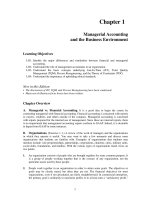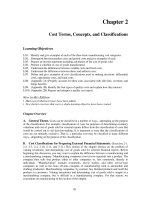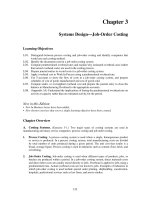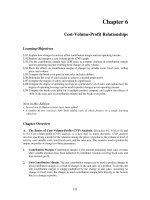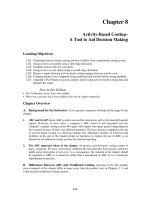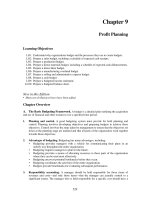Overview managerial accounting chapter 011
Bạn đang xem bản rút gọn của tài liệu. Xem và tải ngay bản đầy đủ của tài liệu tại đây (2.77 MB, 59 trang )
Chapter 11
Flexible Budgets and Overhead Analysis
Learning Objectives
LO1. Prepare a flexible budget and explain the advantages of the flexible budget approach
over the static budget approach.
LO2. Prepare a performance report for both variable and fixed overhead costs using the
flexible budget approach.
LO3. Use the flexible budget to prepare a variable overhead performance report containing
only a spending variance.
LO4. Use the flexible budget to prepare a variable overhead performance report containing
both a spending and an efficiency variance
LO5. Compute the predetermined overhead rate and apply overhead to products in a standard
cost system.
LO6. Compute and interpret the fixed overhead budget and volume variances.
New in this Edition
• New exercises have been added, each of which focuses on a single learning objective.
Chapter Overview
A. Static Budgets. (Exercise 11-8.) The term static budget refers to the budget that is set at
the beginning of a budgeting period and that is geared to only one level of activity—the
budgeted level of activity.
1.
What Is Wrong with a Static Budget? The static budget is appropriate for the budgeted
level of activity but is not realistic for other levels of activity—particularly if variable costs
are significant. If activity is 10% higher than budgeted, then some costs are likely to be
10% higher than budgeted as well.
2.
Static Budgets and Performance Reports. Unfortunately, managers are commonly held
responsible for deviations of actual from budgeted costs. This approach confuses two
different aspects of control—control over the level of activity and control over the effective
use of resources.
3.
Why Do Actual Costs Deviate from Budgeted Costs? Actual costs deviate from
budgeted costs for many reasons. The two most important are: i) the actual level of activity
differs from the budgeted level of activity and ii) the manager’s use of resources was more
or less effective than assumed in the budget. That is, a variance between actual and
696
budgeted costs can be due to a change in activity level or to effective or ineffective cost
control.
4.
Static Budget Comparisons Commingle Effects. If the actual level of activity differs
greatly from the budgeted level, most of the variance for variable costs will almost
certainly be due to the change in activity level. The variance would then be an extremely
noisy indicator of how well a manager controlled costs. And at any rate, the variance
between actual and budgeted costs commingles effects due to changes in activity levels and
due to how well costs were controlled given the level of activity. If a manager is
responsible for the level of activity, control over that aspect of the manager’s responsibility
should be separated from control over costs. And if a manager is not responsible for the
level of activity, it is even clearer that the two effects must be disentangled to have a
meaningful report. The key to resolving this problem is the use of flexible budgets.
B. Flexible Budgets. (Exercises 11-1, 11-7, 11-8.) A flexible budget is geared to all levels of
activity within the relevant range and is used to plan and control spending. The flexible budget
will show the cost formula for each variable cost and total cost (possibly including fixed costs) at
various levels of activity.
C. Overhead Performance Report. (Exercises 11-2, 11-3, 11-4, 11-9, 11-10, 11-11.)
When the actual level of activity differs from what had been assumed in the static budget at the
beginning of the period, we would expect the spending to differ as well. A good overhead
performance report compares actual costs to the flexible budget for the actual level of activity.
Since spending in at least some categories should vary with activity, this is the only way to build
a reasonable benchmark for what the spending should be.
D. Complications when Activity Is Measured In Hours. When a company makes a
number of different products, a unit of one product may require different overhead resources
than a unit of another product. In that situation, adding together units of output from different
products is like adding apples and oranges. Some other measure of activity should be used.
1.
The measure of activity. Three factors should be considered in selecting an activity base
for a flexible budget.
a. The activity base and overhead costs should be causally related. The activity measure
should actually drive the overhead costs. Direct labor-hours is often used as the
measure of activity, but this practice has come under increasing criticism. As discussed
in conjunction with activity-based costing, the links between direct labor-hours and
overhead seem to be getting more tenuous.
b. The activity measure should not be stated in dollars. If the activity measure is stated in
dollars, then changes in prices may be interpreted as changes in activity.
c. The activity base should be simple and easily understood.
2.
Actual versus standard hours allowed and variable overhead variances. When an input
such as direct labor-hours or machine-hours is used as the measure of activity, the question
arises whether actual hours or the standard hours allowed for the actual output should be
used as the measure of activity in performance reports. The following discussion assumes
697
that overhead spending is highly correlated with actual hours; that is, actual hours drives
overhead costs.
a. Actual Hours. When actual hours are used as the basis for the flexible budget
allowance, only a spending variance can be computed for variable overhead. The
variable overhead spending variance is the difference between the actual variable
overhead cost and the budget allowance that is determined by multiplying the actual
hours by the variable overhead rate per hour. A spending variance occurs because
prices differ from those assumed in the flexible budget, because of effective or
ineffective control of overhead resources, or because of inaccuracies in the flexible
budgets themselves. The variable overhead spending variance basically combines price
and quantity variances in one variance. Exhibit YY-6 in the text presents an example of
a variable overhead performance report where the budget is based on actual hours.
b. Standard Hours Allowed. The standard hours allowed could also be used as a measure
of activity in a performance report. However, in this case it is best to compute two
variances rather than just one. The first variance is the variable overhead spending
variance based on the actual hours. The second variance is the variable overhead
efficiency variance based on the difference between the actual hours and the standard
hours allowed for the actual output of the period. The mechanics of these two variances
were covered in Chapter 10.
The variable overhead efficiency variance attempts to estimate the indirect effects on
variable overhead costs of efficient or inefficient use of the activity base. If too many
hours are used to produce the actual output, then presumably this results in additional
variable overhead costs. (Remember the assumption that variable overhead costs are
really proportional to actual hours.) Exhibit YY-7 in the text presents an example of a
variable overhead performance report where both spending and efficiency variances are
computed for variable overhead.
E. Predetermined Overhead Rates (Exercises 11-5, 11-12, 11-14, 11-15.) Predetermined
overhead rates were discussed in earlier chapters, so this is largely a review. The formula for the
predetermined overhead rate used in this chapter is:
Predetermined = Overhead from the flexible budget at the denominator level of activity
overhead rate
Denominator level of activity
Separate predetermined rates can be computed for variable and fixed overhead by including only
variable or fixed overhead costs in the numerator. When overhead is fixed, the predetermined
overhead rate will depend on the denominator level of activity. The higher the level of activity
is, the lower the rate will be.
F.
Applying Overhead in a Standard Cost System. Overhead can be applied to units
based on actual hours or on standard hours allowed for the actual output. In a standard cost
system overhead is applied on the basis of the standard hours allowed for the actual output. This
results in each unit being assigned the same overhead cost—regardless of how many hours were
actually required to make the unit.
G. Fixed Overhead Variances in a Standard Cost System. (Exercises 11-6, 11-13, 1114, 11-15, 11-16.) Two variances are computed for fixed overhead—a budget variance and a
698
volume variance. These variances are quite different from the variances computed for variable
overhead.
1.
Budget Variance. The budget variance is the difference between the actual fixed overhead
costs incurred during the period and the budgeted fixed overhead costs contained in the
flexible budget. This variance is very useful in that it indicates how well spending on fixed
items was controlled.
Students are often confused about the controllability of fixed costs. Contrary to intuition,
fixed costs are often far easier to control than variable costs. For example, it is usually
much easier to control spending on convention travel (a fixed cost) than on direct materials.
The term fixed does not mean the cost can’t change. A fixed cost can change and it may
depend on a number of factors; however, it does not depend on the level of activity during
the period.
2.
Volume Variance. The volume variance is the difference between the total budgeted fixed
overhead and the fixed overhead applied to production. Alternatively, it can be expressed
as follows:
(
Fixed portion of
Volume = the predetermined Denominator − Standard hours allowed
variance
hours
for the actual output
overhead rate
)
The volume variance occurs because the denominator level of activity differs from the
standard hours allowed for production. Thus, an unfavorable variance means that the
company operated at an activity level below the denominator level of activity. Conversely,
a favorable variance means that the company operated at an activity level greater than the
denominator level of activity. Some would call the volume variance a measure of the
utilization of plant facilities relative to the planned utilization. Others who are less
charitable would call it the error that is induced in the costing system by assuming that
fixed costs are variable.
H. Under- and Overapplied Overhead. The sum of the four manufacturing overhead
variances—variable overhead spending, variable overhead efficiency, fixed overhead budget,
and fixed overhead volume—equals the under- or overapplied overhead for the period.
1.
The sum of the variances equals under- or overapplied overhead. The four overhead
variances measure the difference between actual overhead costs incurred and the standard
overhead cost for the actual output. The under- or overapplied overhead measures the
difference between actual overhead costs incurred and the overhead applied to inventory. In
a standard cost system the amount of overhead cost applied to inventory is the standard
cost, so the variances and the under- or overapplied inventory measure the same thing.
Therefore, they must sum to the same number.
2.
Underapplied overhead is equivalent to an unfavorable variance. If overhead is
underapplied, more overhead cost was incurred than was applied to inventory. The amount
applied to inventory is the standard cost allowed for the actual output. Therefore, if
overhead is underapplied, more overhead cost was incurred than was allowed for the actual
output—hence, the overall variance is unfavorable. Similar reasoning leads to the
conclusion that overapplied overhead is equivalent to a favorable variance.
699
Assignment Materials
Assignment
Exercise 11-1
Exercise 11-2
Exercise 11-3
Exercise 11-4
Exercise 11-5
Exercise 11-6
Exercise 11-7
Exercise 11-8
Exercise 11-9
Exercise 11-10
Exercise 11-11
Exercise 11-12
Exercise 11-13
Exercise 11-14
Exercise 11-15
Exercise 11-16
Problem 11-17
Problem 11-18
Problem 11-19
Problem 11-20
Problem 11-21
Problem 11-22
Problem 11-23
Problem 11-24
Problem 11-25
Problem 11-26
Problem 11-27
Problem 11-28
Problem 11-29
Problem 11-30
Case 11-31
Case 11-32
Case 11-33
Case 11-34
Level of
Topic
Difficulty
Prepare a flexible budget ..........................................................
Basic
Preparing a flexible budget performance report .......................
Basic
Variable overhead performance report with just a spending
variance................................................................................
Basic
Variable overhead performance report with both spending
and efficiency variances ......................................................
Basic
Applying overhead in a standard costing system .....................
Basic
Fixed overhead variances .........................................................
Basic
Preparing a flexible budget.......................................................
Basic
Using a flexible budget.............................................................
Basic
Flexible budget performance report .........................................
Basic
Variable overhead performance report .....................................
Basic
Variable overhead performance report with both spending
and efficiency variances ......................................................
Basic
Predetermined overhead rate ....................................................
Basic
Using fixed overhead variances................................................
Basic
Predetermined overhead rate; overhead variances ...................
Basic
Relations among fixed overhead variances ..............................
Basic
Fixed overhead variances .........................................................
Basic
Applying the flexible budget approach ....................................
Basic
Comprehensive standard cost variances ...................................
Basic
Comprehensive standard cost variances ...................................
Basic
Preparing an overhead performance report ..............................
Basic
Applying overhead; overhead variances...................................
Basic
Flexible budget and overhead analysis..................................... Medium
Evaluating an overhead performance report............................. Medium
Variable overhead performance report ..................................... Medium
Standard cost card; fixed overhead analysis; graphing ............ Medium
Comprehensive problem; flexible budget; overhead
performance report .............................................................. Medium
Applying overhead; overhead variances................................... Medium
Flexible budget and overhead performance report ................... Medium
Selection of a denominator; overhead analysis; standard cost
card ...................................................................................... Medium
Activity-based costing and the flexible budget approach......... Difficult
Ethics and the manager............................................................. Medium
Preparing a performance report using activity-based costing... Difficult
Working backwards from variance data................................... Difficult
Comprehensive variance analysis; incomplete data ................. Difficult
700
Suggested
Time
15 min.
15 min.
15 min.
20 min.
15 min.
15 min.
15 min.
10 min.
15 min.
20 min.
15 min.
15 min.
15 min.
20 min.
15 min.
10 min.
30 min.
45 min.
30 min.
30 min.
45 min.
45 min.
30 min.
20 min.
45 min.
45 min.
45 min.
30 min.
45 min.
60 min.
30 min.
45 min.
60 min.
90 min.
Essential Problems: Problem 11-18 or Problem 11-19, Problem 11-20 or Problem 11-23,
Problem 11-21 or Problem 11-22.
Supplementary Problems: Problem 11-17, Problem 11-24, Problem 11-25, Problem 11-26,
Problem 11-27, Problem 11-28, Problem 11-29, Problem 11-30 or Case 11-32, Case 11-31,
Case 11-33, Case 11-34.
701
1
702
Chapter 11
Lecture Notes
Helpful Hint: Before beginning the lecture, show
students the 12th and 13th segments from the second
tape of the McGraw-Hill/Irwin Managerial/Cost
Accounting video library. These segments introduce
students to many of the concepts discussed in chapter
11. The lecture notes reinforce the concepts introduced
in the video.
1
Chapter theme: This chapter expands the study of
overhead variances that was started in Chapter 10. It also
explains how flexible budgets can be used to control
variable and fixed overhead costs.
“In Business Insights”
Overhead costs are increasing for many organizations;
consequently, controlling overhead costs is becoming a
topic of growing importance. For example:
“Focus on Overhead Costs” (page 492)
• A published study shows that overhead costs now
account for as much as 66% of the costs incurred
by companies in service industries and up to 37%
of the total costs of manufacturers.
• As companies seek to reduce these overhead
costs, they must avoid cutting costs that add value
to the organization in the form of improved
product or service quality.
703
2
3
704
I.
Flexible budgets
A. Key definitions:
i.
2
A static budget is prepared at the beginning of
the budgeting period and is valid for only the
planned level of activity. It is suitable for
planning, but it is inadequate for evaluating
how well costs are controlled because:
1. The actual level of activity is unlikely to
equal the planned level of activity, thus
resulting in “apples-to-oranges” cost
comparisons.
ii.
3
A flexible budget provides estimates of what
costs should be for any level of activity within
a specified range. When used for performance
evaluation purposes, actual costs are compared
to what the costs should have been for the
actual level of activity during the period. This
enables “apples-to-apples” cost comparisons.
B. Deficiencies of the static budget
Helpful Hint: Before beginning this discussion, ask
students to put themselves in the shoes of a production
manager for a toy company that had a runaway hit for
the Christmas season. By adding an extra shift and
working very hard, the factory was able to produce
enough toys to satisfy unexpected customer demand.
Then, at the end of the year, the manager was
confronted with an unfavorable variance report
because more money was spent in the factory than had
705
4
5
6
7
8
9
10
706
been budgeted at the beginning of the year. Ask
students how they would respond.
i.
4
5
6
7
8
9
10
CheeseCo – an example
1. Assume that CheeseCo prepared the static
budget as shown. Notice:
a. The budget is based on an activity level
of 10,000 machine hours.
2. Assume that the actual results for the period
were as shown. Notice:
a. Only 8,000 machine hours were
actually worked, thus resulting in
“apples-to-oranges” comparisons with
the static budget.
3. The variances between the static budget and
actual results would be as shown. Notice:
a. The machine hour variance is 2,000
unfavorable because CheeseCo was
unable to achieve the budgeted level of
activity.
b. All of the variable overhead cost
variances are favorable because actual
costs were less than budgeted costs.
4. These favorable variances beg the question –
Has CheeseCo done a good job of
controlling costs?
a. The answer is unclear because the
actual activity level (8,000 machine
hours) does not equal the budgeted
activity level (10,000 machine hours).
5. This raises an additional question, namely –
How much of the favorable cost variance
is due to lower activity, and how much is
707
10
11
708
due to good cost control? To answer this
question, we must “flex” the budget.
10
C. How a flexible budget works
i.
11
Key assumptions:
1. Total variable costs change in direct
proportion to changes in activity.
2. Total fixed costs remain unchanged within
a specified activity range.
“In Business Insights”
Understanding the difference between variable and
fixed costs is important to organizations. For example:
“Know Your Costs” (page 504)
• Kennard Wing of the OMG Center for
Collaborative Learning, reports that a large
health care system made the mistake of
classifying all of its costs as variable.
• As a consequence, when volume dropped,
managers felt that costs should be cut
proportionately and more than 1,000 people were
laid off – even though the workload of most of
them had no direct relation to patient volume.
• The result was that morale plummeted and within
a year the system was scrambling to replace not
only those it had let go, but many others who had
quit.
709
12
13
15
16
710
14
12
ii.
The CheeseCo example – continued
1. The key to preparing a flexible budget is to
specify the amount of each variable cost per
unit of activity. Notice:
13
14
15
16
a. Indirect labor is $4.00 per machine
hour, indirect material is $3.00 per
machine hour, and power is $0.50 per
machine hour.
• We can verify these numbers by
dividing the total cost according
to the static budget by the total
amount of the activity per the
static budget.
b. While variable costs are expressed per
unit of activity, fixed costs are not.
They are expressed as a total amount.
2. The flexible budget for an activity level of
8,000 machine hours would be prepared as
follows:
a. Multiply the cost per hour for each
type of variable cost by the activity
level of 8,000 hours.
• In the case of indirect labor,
multiply $4.00 per hour by 8,000
hours to yield a budgeted
amount of $32,000.
b. Add the fixed costs, which remain
unchanged, to yield a total overhead of
$74,000.
3. The flexible budget at 10,000 hours of
activity is $89,000. This equals the amount
from the static budget that was presented
earlier in this example.
711
16
17
18
19
20
21
22
23
24
712
a. Notice, the total variable costs did
change (compared to the flexible
budget at 8,000 hours), while the total
fixed costs did not change.
16
17-18
Quick Check – preparing a flexible budget
4. The flexible budget at 12,000 hours is as
shown. The answer to the Quick Check of
$104,000 is shown in the bottom right-hand
corner.
19
D. Using flexible budgets for performance evaluation
20
i.
21
22-23
24
The CheeseCo example – continued
1. Recall from earlier in our example that
CheeseCo’s actual activity level was 8,000
machine hours and its actual costs were as
shown.
2. To enable an “apples-to-apples”
comparison, a flexible budget based on an
activity level of 8,000 machine hours
should be used to calculate variances that
will be used to evaluate performance.
Quick Check – variance calculations
3. As shown in the solution to the Quick
Check question, the indirect labor variance
is $2,000 U.
713
25
26
27
28
29
30
31
714
25-26
27
28
29
30
31
Quick Check – variance calculations
4. As shown in the Quick Check question, the
indirect material and power variances are
$1,500 U and $200 F. In addition, the fixed
cost variances for Depreciation and
Insurance are $0 and $50U, respectively.
5. The flexible budget that we just prepared
enables us to answer the previously posed
question – “How much of the total
variance is due to lower activity and how
much is due to cost control?”
a. Recall from our “apples-to-oranges”
comparison that was done earlier, that
CheeseCo’s static budget variance was
$11,650 F.
b. This difference of $11,650 can be
depicted pictorially as shown.
c. If we insert the flexible budget at
8,000 machine hours in the middle of
this diagram, it enables us to compute
two variances that answer the
aforementioned question.
• $15,000 F is due to a lower
activity level.
• $3,350 U is due to poor cost
control.
• These two amounts net to
$11,650 F.
“In Business Insights”
The focus of variance analysis inquiry should just be on
unfavorable variances, rather favorable variances
715
32
716
should also be examined to enable organizational
learning. For example:
“Focus on Opportunities” (page 497)
• Management guru Peter Drucker cautions
managers that “almost without exception, the first
page of the monthly report presents areas in
which results fall below expectations or in which
expenditures exceed the budget.”
• Drucker suggests that a new first page be created
for monthly reports that focuses on where results
are better than expected. He contends that while
problems cannot be ignored, enterprises have to
focus on opportunities.
E. The measure of activity – a critical choice
i.
32
At least three factors are important in
selecting an activity base for an overhead
flexible budget.
1. The activity base and variable overhead
costs should be causally related.
2. The activity base should not be expressed
in dollars or other currency.
a. For example, direct labor cost is
usually a poor choice for an activity
base because changes in wage rates do
not result in proportionate changes in
overhead.
3. The activity base should be simple and
easily understood.
Helpful Hint: Compare a carpentry shop with an almost
fully automated process such as beverage production,
717
33
34
718
where machine-hours would be a more appropriate
activity base.
II.
Variable overhead variances – a closer look
A. Actual versus standard hours
i.
When the flexible budget is based on hours of
activity, the quantity of hours chosen can be
based on actual hours or the standard hours
allowed for the actual output.
33
1. If the actual hours are used, only a spending
variance can be computed.
2. If both the actual and standard hours are
used, both a spending and an efficiency
variance can be computed.
B. ColaCo – an example
i.
34
Assume the following:
1. ColaCo’s actual production for the period
required 3,200 standard machine hours.
2. Actual variable costs incurred during the
period was $6,740.
3. 3,300 machine-hours were actually worked
during the period.
4. The standard variable overhead cost per
machine hour is $2.00.
719
35
36
38
39
720
37
